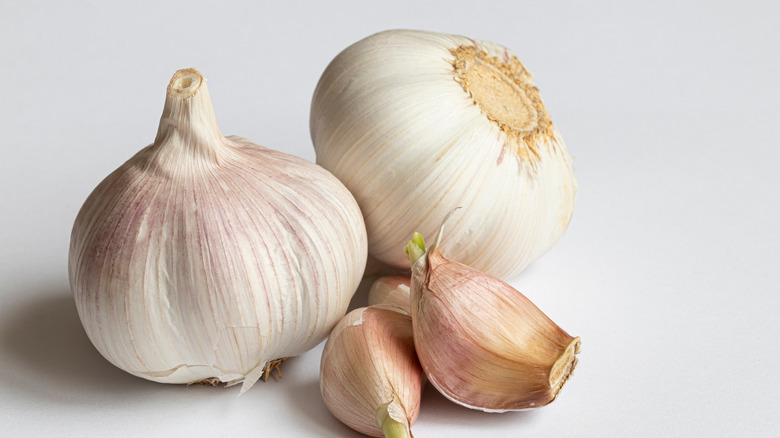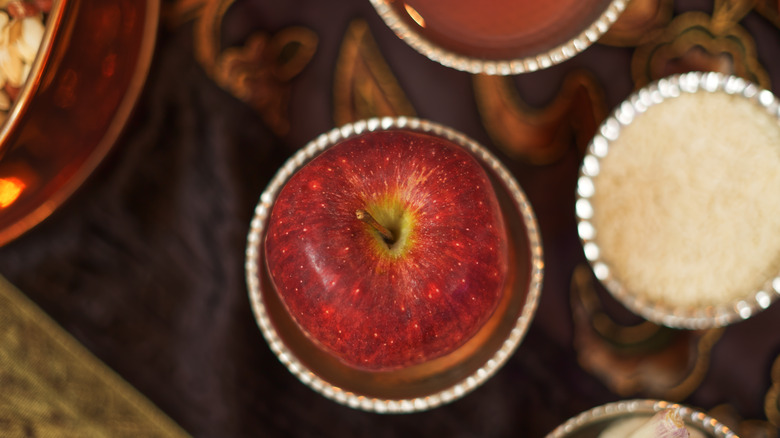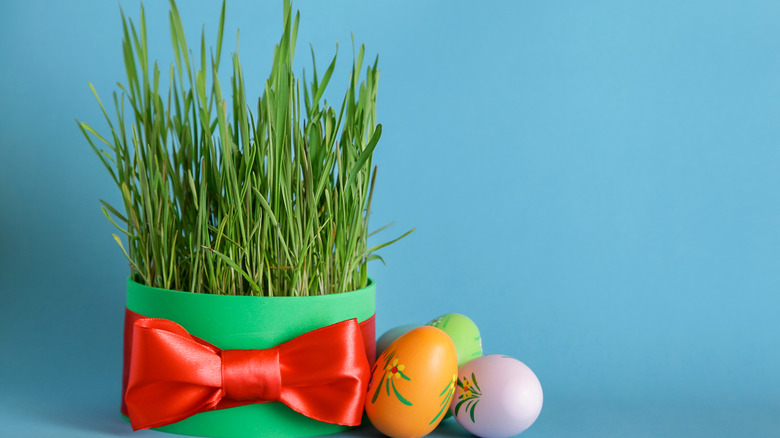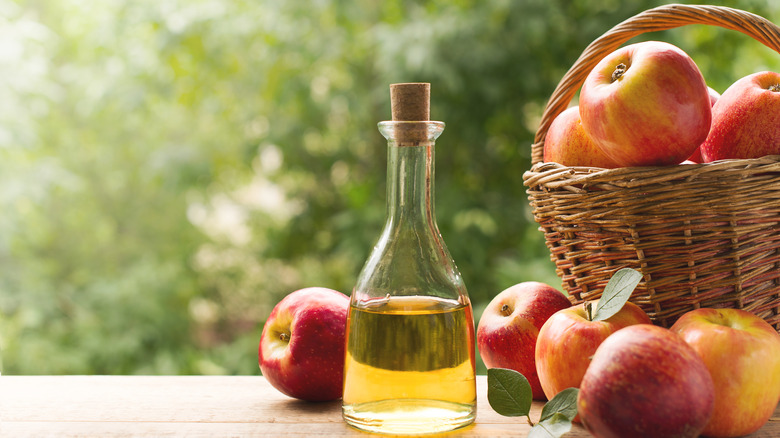Haft Sin: The 7 Symbolic Tastes Of The Persian New Year
Nowruz marks the first day of the Zoroastrian calendar and always falls on the spring equinox, usually March 21st. While Nowruz may be most famously celebrated in Iranian and Persian households, it is also celebrated all around the world. Nowruz is rooted in Zoroastrianism, a Persian religion that dates back further than Christianity or Islam. Over the 13 days of festivities, Nowruz celebrates nature, reinforces familial and community ties, and is based on the values of peace, coexistence, and respect.
Before Nowruz, many families will set up a Haft Sin, which is a display, often on a table or the floor, that as a whole represents renewal for the new year. A Haft Sin table hosts a collection of symbolic foods which vary from family to family. However, the staple seven in this article must always be present. The reason there are seven, and all start with the letter "s," or in the Farsi alphabet "sin," is incredibly intentional.
Seven represents the seven eternal laws of the Iranian prophet Zarathushtra. The "s" or "sin" is because Haft Sin used to be known as Haft-Sheen, or seven "sh's," with sharab (wine) being the most important. After Islam came to ancient Persia, sharab was outlawed and replaced by serkeh (vinegar). Subsequently, each Haft Sin item was also changed to start with the letter "s."
Keep reading to know a little bit more about the specific components of a Haft Sin and what they individually represent for the new year.
Seer
While the order of the seven s's is not as important as their individual presence, the first item that we will start with is seer, which in Farsi means garlic (and any variation of garlic will do). Each item included in a Haft Sin represents something important that is being hoped for in the new year. Seer in particular represents health and medicine, two incredibly valuable aspects of a quality life.
For obvious reasons, wishing for good health and wellness in the new year is an essential part of Nowruz tradition and therefore, an equally important aspect of a Haft Sin. Garlic is also seen as having a cleansing power and as a symbol of dignity and environmental purity.
Some people believe that garlic is included because it represents Ahura Mazdā, the supreme god in ancient Iranian religion and Zoroastrianism. Zoroastrianism is the religion of the Iranian prophet Zarathustra who stated that Ahura Mazdā was the creator of the universe. Therefore, including garlic in a Haft Sin is also a symbol of protection against evil.
To include seer in your display, you can simply place one or two whole heads of garlic in a small dish and add it to your arrangement to complete the symbolic placement. The garlic is shelf-stable so can sit out with the other non-perishable items for the days leading up to the new year.
Seeb
The next item in a Haft Sin is seeb, which in Farsi means apple. These unassuming fruits that we often take for granted are a must-have in any Haft Sin and have a very important symbolic meaning. However, apple's importance is cross-cultural. These red, green, yellow, or speckled fruits hold many meanings in many cultures. For example, on Rosh Hashanah, the Jewish new year, apples are dipped in honey to symbolize prosperity and people's hopes for the year to come.
In Persian and Iranian cultures, seeb included in a Haft Sin represents health, similarly to seer. However, unlike seer, seeb symbolizes health from the angle of beauty and is specifically oriented around keeping family members safe and in good health. While seer is a more general symbol of environmental health, seeb is a way to protect and wish for those around a given table to be protected from disease in the year to come.
As we mentioned, seeb also represents beauty, since apples, specifically red apples, are typically associated with beauty. This is also not an uncommon narrative and can partly be explained by red apples' natural shine, bright color, and often candy-sweet taste. Like seer, seeb are shelf-stable, at least before they are cooked or cut into, so it is fairly simple to include them in a Haft Sin.
Sabzeh
Sabzeh, which refers to sprouted grains, is another essential component of a Haft Sin. These sprouted grains, with their vibrant green, fresh leaves, bring some brightness to the display. They are also an excellent indication of the beginning of spring.
Nowruz, the Persian new year, is the celebration of light over dark. At its core, Nowruz is a way to acknowledge and appreciate the changing of the seasons from winter into spring. The Spring equinox is very important because it is a tipping point for the solar calendar, and indicates the transition from days getting shorter to longer. Although the equinox is a very important day, Nowruz celebrations will carry on for weeks after the equinox as a way to celebrate the triumph of good over evil and the warming of weather. By now perhaps you have some idea of why sabzeh is an essential part of Haft Sin. These sprouts, whether they are wheat, lentils, or barley, symbolize new beginnings and rebirth.
In order to have sabzeh ready for Nowruz, specifically the New Year's Day celebrations on March 21, some prior planning must be undertaken. Planting the lentil, barley, or wheat a couple of weeks before Nowruz and the equinox will ensure that you have vivacious green sprouts to celebrate with. The grass sprouts are grown in a dish that can be placed next to your other items as a welcoming splash of spring greenery.
Serkeh
Because the Haft Sin table has been prepared for centuries, there are few written records of the traditions. However, some historians agree that Haft Sin originated as a way to celebrate nature and the good it brings. At the beginning, the name of each item on the Haft Sin table started with a different letter, but after the eighth or ninth centuries, it became customary for the items to begin with the letter "s."
In Persian culture, vinegar is an essential component of a Nowruz Haft Sin display. There are many different types, of course, but in Farsi, vinegar translates to serkeh. Often served in a small bottle or dish, serkeh is a must-have during Nowruz. The serkeh at a Haft Sin represents various things, with the most common symbolism being patience and age. More specifically, it represents the patience that comes with age, as well as understanding. Serkeh also symbolizes the angel of immortality and satisfaction, which in this context means the acceptance of the difficulties and hardships in life in order to reach happiness.
In the original Haft Sin, serkeh was not included. Rather, sharab was used in place of serkeh. Sharab means wine in Farsi, and after the Islamic conquest of Persia, sharab became forbidden under Islamic law. Therefore, sharab was replaced with serkeh for Haft Sin, and to this day serkeh remains an essential offering.
Senjed
While the English translation of senjed is dried fruit, the actual senjed that is always included in a Haft Sin is specifically from oleaster. This senjed represents love and affection. This can be interpreted in many ways, but the main interpretation is that oleaster is a major symbol for familial love, and serves as a way to wish for the affection between family members to grow stronger in the new year.
So we know what senjed is, but what exactly is oleaster? Oleaster is also known as a Russian olive or trebizond date, which may be because of the fruits the oleaster tree produces, which are about the size of an olive and pale yellow in color.
These small berries, which are sweet when fresh, and even sweeter once they have dried, are an essential component of Haft Sin. While senjed does represent love and affection, it is said that senjed represents the angel of Khordad, also known as the angel of attachment. Senjed is then placed on the table as a way to wish for health of the body, especially for children and the elderly. Senjed also represents caution. Placing senjed on the Haft Sin table is a way to remind all family members to be careful in the new year.
Somagh
If you have ever seen or eaten sumac, you will understand why it symbolizes what it symbolizes in the Haft Sin display. Sumac is a berry that grows in the Southwest Asian and North African (SWANA) region, primarily in Iran and Turkey. Sumac berries are harvested and then either soaked to infuse water or dried and ground into a powder that is often bright red. The color of the final sumac powder is determined by the color of the berries which can come in many varieties, with the iconic sumac red being the most common. Some sumac berries, such as the white ones, are poisonous.
As you probably gathered, sumac, or somagh in Farsi, is one of the essential seven items that must be placed on the floor or table to complete Haft Sin. Somagh, it should come as no surprise, represents the sun and sunrise thanks to its vibrant red color. And since somagh symbolizes the sun, it also symbolizes the life and prosperity that can come from the sun.
Somagh also represents patience and is a way to encourage those around the Haft Sin table that they must approach everything with patience. Especially in regard to the new year, somagh is a reminder to enter and proceed through the new year with forbearance and tolerance. The bright red color of this beloved spice will bring a warm glow to the whole room and you will understand why it is the embodiment of the sun.
Samanoo
The other items in a Haft Sin are all shelf-stable items that can stay at room temperature for months. However, samanoo is the only prepared food item on the list, and this means that it must be stored in the refrigerator until the day of.
To make samanoo, you must start a couple of days before in order to give the wheat berries ample time to sprout. The first step involves soaking the wheat for two to three days until it has sprouted. Then the wheat needs to be dried so that it can be ground into flour before being stewed into samanoo. Once the flour is ground, you can finally make samanoo by combining your wheat flour with water and letting it simmer for anywhere from three to 24 hours.
The samanoo is finished when it is reddish brown, and thanks to the natural sweetness of the wheat, it does not need any additional sugar. This lengthy process is well worth it because the final samanoo is smooth, comforting, and slightly sweet. This slight sweetness aligns well with samanoo's symbolism, which is the sweetness of life.
Samanoo also represents affluence as well the reward of patience, like sabzeh. Altogether, this makes samanoo a very important addition to a Haft Sin because it signifies the coming of sweetness and happiness in the new year, and hopefully beyond.







